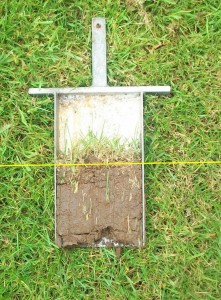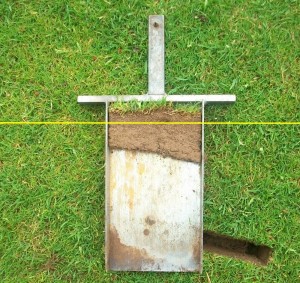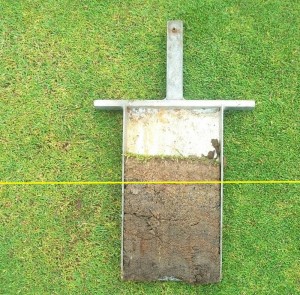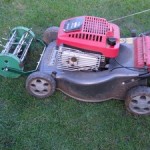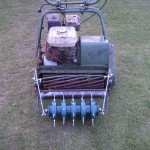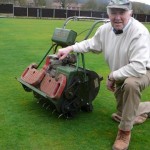
In response to my request for readers to share their ideas and experiences, Bowls-Central regular Syd Kennerley sent me a photo of his green aerator a few weeks ago.
This is a machine that Syd designed and built himself and it seems to be a very effective addition to his machinery shed.
Syd kindly agreed to share the story with us, so here it is in Syd’s own words:
John
Some 15 years ago I decided to buy a spiker for our Bowling green; it was a two cylinder job, about two feet wide.
When pulling it, the spikes went in to about one inch depth, but I noticed when I pushed the machine in front of me it then went in to a depth of about two inches.
In those days I was a farmer and agricultural contractor, I had done Moto cross riding, Football, and also a bit of tug o war so I was reasonably fit and not frightened of hard work, but I swear to you had I continued spiking our green with that machine I would now be bowling on that superb green just beyond those Pearly Gates.
I had to find a better solution to spiking the green and I had an old 24inch ride on mower which was surplus to requirements which I had already decided to sell at an implement sale at our local cattle market. I loaded the old mower and dropped it off at the sale and on the way home I stopped off to take a look at the green.
I thought “this green could do with spiking” but I couldn’t face yet another trudge over the green with the old spiker. While driving from the green to home I started thinking that I could make a powered spiker by using the old mower, yes the mower that was about to be sold at the implement sale!I couldn’t get back in time to stop the mower being sold, so I rang the market and told them to put a reserve price of £500 on it and of course I got a phone call around 5pm to say the mower had not been sold due to the high reserve.
With the mower back I was able to make a start on my project. I started by removing the cutting cylinder and front roller. I then removed the rear drive rollers as that was where I wanted the spike rollers to fit thus making a powered spiker. The front roller I then mounted behind the spiked cylinders; so that I could rock it back onto it for turning corners. I also used the guard of the spiker as you can see on the photo.
The day of the trial run arrived on my lawn at home with just my wife to witness this grand occasion. I set the throttle just nicely ticking over and released the clutch. When she managed to finally stop laughing my wife saidif I had not held on to it so tightly it would have out raced me to the thornedge without a shadow of doubt, so back into the workshop yet again.After many visits to a lawnmower repair firm sifting through all his old sprockets, chains, and bushes I eventually got there, now ticking over it goes at a slow walking pace.
For the photo, I have taken the guard off so you can see the gearing down sprockets. You will also notice the two weights which slot onto the front;with these on it will go down to maximum depth if needed. When spiking the green I start on the outside and keep going round and round until I get to the centre, the reason for this is the machine works best going in straight
lines so doing it this way I only have to make 90 degree turns rather than 180 degree, if I went back and forth as you would to cut the green.
It also helps to keep compaction to a minimum and away from along the side where you might want to start your matches from.I hope I have not spoiled the picture with having yours truly on it!Thanks again John, for all your help and information you pass to me,
Regards
Syd.
Thanks Syd for this fantastic story; a great example of the ingenuity and resourcefulness that goes on at clubs around the country and an example of the kind of helpful thinking we need to adopt in the future if we are going to have thriving bowling clubs.
Now Syd, I need to know before Sunday: Have you ever played rugby (even once!) and do you have any distant Scottish relatives?

